Mogontiacum (Mainz)
Q571790Mogontiacum: Roman city, capital of Germania Superior, important military base, modern Mainz.
Early history
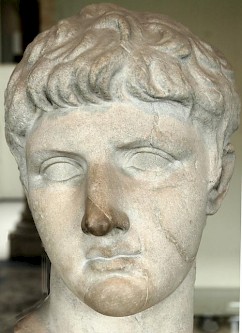
The first Romans must have reached Mogontiacum in 57 or 56 BCE, during Julius Caesar's Gallic War, in which he made the river Rhine the frontier of the Roman Empire. The people living in the two villages (identified near Bretzenheim and Weisenau) belonged to the La Tène culture, which means that they spoke a Celtic language, worshiped Gallic gods, and knew how to work iron. They may have belonged to a subtribe of the Treveri, such as the Aresaci or Caeracati, and were left in peace.
The Romans adapted the old name of the site: "the land of Mogon". In an inscription from Saalburg, a god with this name is identified with Apollo Grannus, a god of health. A sanctuary dedicated to this deity must have been wealthy enough to attract the attentions of the Roman taxmen, because elsewhere in the Rhineland, place names ending on -iacum are invariably indicate tax districts (e.g, Arenacum and Mannaricium). The rich landowners must have prefinanced the taxes.
However, after the Roman governor of Gallia Belgica, Marcus Lollius, had been defeated by tribes that, from a Roman point of view, were supposed to remain on the east bank, the emperor Augustus decided that the Rhine was to become the base for campaigns against those eastern tribes, which the Romans called Germans. He sent his adopted son, Drusus, to Gaul, and this prince founded several military bases along the river: Nijmegen, Xanten, and Mainz were probably built in 13 BCE.
Military base
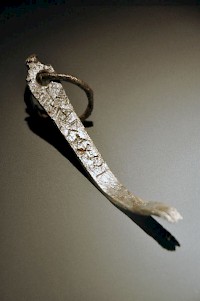
The site of Mainz was of great strategic significance. On the opposite bank, the navigable river Main emptied itself into the Rhine, which made Mainz a perfect base for operations in the east, where a subtribe of the Chatti, the Mattiaci, lived. Xanten controlled access to another river, the Lippe, and it comes as no surprise that the Roman legions were divided into two armies that were responsible for the conquest of a river valley. During the next years, Drusus conducted several campaigns and when he died in 9 BCE, the Rhine had become a Roman river. A monument that may have been the cenotaph of the young general was erected in Mainz.
The legionary base, castra in Latin, has been discovered in the part of Mainz that is still known as Kästrich, in which the ancient name survives. It measured about 36 ha an offered accommodation for two legions. Their names are not known, but I Germanica and V Alaudae are among the more plausible candidates. However this may be, many veterans stayed in Mainz, and because they were born in Italy, in one of the cities on the plain of the Po, or in the Provence, it is likely that the Latin language rapidly spread to Mainz.
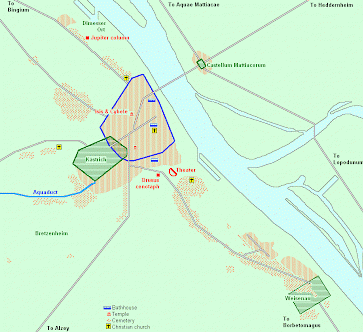
At the beginning of the common era, Mainz was already a complex settlement. There were two native villages, there was a very large wooden fortress at Kästrich and a second one, used when troops were assembled, at Weisenau, four kilometers to the southeast. East of Kästrich was a growing civil settlement, there was a river port, and beyond this town was the Rhine. There was a pontoon bridge and across the river was a bridgehead called Castellum Mattiacorum, probably built in 4 CE.
Beyond the bridge, the Roman roads into the interior started. One led across the Taunus mountains to a new town called Waldgirmes, and another led along the Main to the east, where Marktbreit was built as a base for future conquests. The soldiers of I Germanica and V Alaudae probably expected to be transferred to the east soon.

This was not to be, however. In September 9, the army of the Lippe, which consisted of the legions XVII, XVIII, and XIX and was commanded by Publius Quinctilius Varus, was destroyed in the Battle in the Teutoburg Forest. The garrison of Mainz was immediately transferred to the north, and new units were directed to Mainz: XIV Gemina arrived from Illyricum and XVI Gallica arrived from a base in Switzerland or Bavaria.
Other legions are also known to have been in Mainz. The Roman commander Germanicus, a son of Drusus, conducted several campaigns on the east bank, and units like XIII Gemina and II Augusta are known to have stayed in Mainz. The latter probably recruited its soldiers among the Roman citizens of the Iberian peninsula, making the city on the confluence of the Rhine and Main more cosmopolitan.
The first century
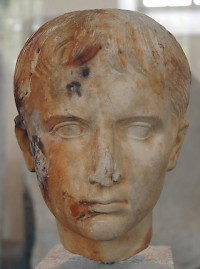
The civil settlement between the river and the Kästrich fortress has been inhabited ever since, which makes excavation difficult. Important sites like the forum have not yet been found. However, the theater has been identified. The pontoon bridge was replaced in 27 by a more massive one, supported by at least 21 piers. Six years later, the bathhouse was build. A column dedicated to the supreme god Jupiter has been excavated to the north of the ancient town. And everywhere along the ancient roads, sepulchral monuments have been excavated.
The opposite bank of the Rhine was inhabited by a tribe known as Chatti. In 39, the emperor Caligula decided to attack them. According to our sources, this campaign was not really important, even something of a joke, but archaeological finds suggest that this is not true. Two new legions were recruited, the Fifteenth and Twenty-Second Primigenia. The fifteenth legion was added to XIV Gemina and XVI Gallica (hence the number), and for a while, three legions were staying in Mainz. One of the recruits was a man named Lucius Varius Sacco of Milan. He died in Mainz after only one year of service, which almost certainly means that he was killed in action. He was twenty-five.
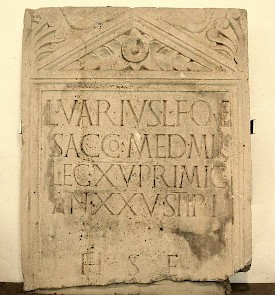
The operations were brought to a good end in the winter of 40/41, when Servius Sulpicius Galba (the future emperor) overcame the Chatti. After this success, troops could be reallocated, and when the emperor Claudius invaded Britain, the legions of Mainz were transferred. The new units were IIII Macedonica (which recruited its soldiers in Gallia Narbonensis) and Caligula's XXII Primigenia. They were still in Mainz in 69.
Troubles announced themselves in 68, when the emperor Nero committed suicide. He was succeeded by Galba, who distrusted the army of the Rhine. Unfortunately, he showed this a bit too much, and the legions revolted, proclaiming the general of the army of the Lower Rhine, Vitellius, emperor on 2 January 69. The garrison of Mainz supported him and took part in his march on Rome, where he was recognized by the Senate.
At that moment, however, the Batavians, a tribe living along the Lower Rhine, revolted. Because the garrisons were depleted, the rebels were able to capture Xanten and Cologne, force the remaining Roman units into surrender, and conquer parts of the Rhineland. The civil settlement of Mainz was taken by a rebel named Julius Tutor.
However, during the early spring of 70, the city liberated itself, and welcomed the Roman army commanded by Quintus Petillius Cerialis, a relative of Vitellius' enemy and successor Vespasian. Order was restored in the Rhineland. The new troops were the recently founded I Adiutrix (from Central Italy) and (again) XIV Gemina. The soldiers rebuilt the fortress out of stone and added an aqueduct with a length of nine kilometer. The source was near a village now called Finthen (from Latin fontes), and the remains of the arches can still be seen. At the same time, the first temple dedicated to Isis was erected.
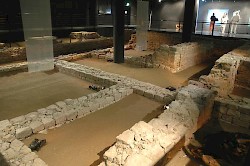
In these years, the Romans started to improve their positions on the east bank (the Taunus limes). The angle between the Rhine and Danube was conquered to achieve what was essentially en easier defense of Gaul and the Alps. This created some tensions among the tribes on the east bank, and in 83, the emperor Domitian, a son of Vespasian, felt himself forced to subdue the Chatti on the east bank. One of the legions that was in these years added to the garrison of Mainz was XXI Rapax, which arrived from Windisch in Switzerland. The impressive Mainz Pedestals are from this period.
The second century
After the war against the Chatti, the Rhine frontier became quiet and the military zone was given the status of a civil province. Because there were still two armies, there two provinces, called Germania Inferior (capital Cologne) and Germania Superior, which had Mainz as seat of the governor. However, the emperor was not successful in finding a good representative, because in 89, governor Lucius Antonius Saturninus revolted. It was soon repressed, and the city was punished by recalling one legion, which meant that only half the money was spend in Mainz. This also meant that at Kästrich, new space became available to the legionaries, who now started to build a bathhouse.
The city became increasingly a civil settlement. There are far less military monuments from the second century, when the city and the town near Weisenau flourished. One of the monuments from this period is the theater, which replaced an older structure. (It was a large building, bigger than the theaters of Arles, Orange, or Lyon) The city also built a new river port. There is no real explanation for the rapidly rising number of inscriptions dedicated to the Roman and native gods. Jupiter, Juno, Mars, Apollo (= Mogon?), the Matres, Sirona, and Bellona are well-attested. It is possible that the religious center was near the present cathedral.
The third century
The remaining military unit, XXII Primigenia, was to stay in the city for the next three centuries, defending the Rhine against the well-known Chatti and the Alamans, a new tribal federation. So, Mainz still had a military function, and it is not surprising that the emperor Caracalla, who in 213 fought against the Germanic tribal federation of the Alamans, visited the city and sacrificed to Apollo Grannus.
In the third century, pressure on the Roman frontier increased, and often, emperors had to wage war. Not always with success, however. In 235, the garrison of Mainz, perhaps enlarged with IIII Italica, was angry when the young emperor Severus Alexander and his mother Julia Mamaea wanted to solve the Alamannic problem by diplomacy, not war. They were lynched and the throne was given to Maximinus Thrax, a capable general who gave the soldiers the war and loot they wanted.
From the mid-third century survives a small honorific arch, dedicated to the imperial family by a man named Dativius Victor.
In 259, the limes collapsed and Mainz became a frontier city again. For the first time, the civil settlement as surrounded by walls, which connected the fortress of Kästrich with the river. Erecting them was obviously a quick job, because most stones were recycled from older buildings.
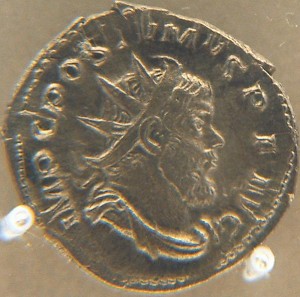
The walls may have been built by Postumus, the man who created an independent Gallic Empire. Although technically a usurper, he restored order, expelled the Franks and Alamans, reorganized the frontiers, and protected the economy of Gaul. It is possible, but not very likely, that another legion was temporary staying at Mainz, the mysterious Sixth Gallicana, mentioned only in the notoriously unreliable Historia Augusta.note
Postumus' end came in 269. His coins had always been of a better quality than those of the official empire, but in 268, he unexpectedly lowered the amount of silver in his coins. This created unrest and a man named Laelianus seized the mint of Cologne, proclaimed himself, and made Mainz his capital. Postumus immediately suppressed the rebellion and did not give his soldiers permission to sack the city. The only result was for the second time, an emperor was killed by his own soldiers in Mainz.Not much later, the "official" emperor Aurelian conquered Gaul and the Germanies, stripped them of their armies, and opened the road for Alaman and Frankish invasions again.
Late Antiquity
Order was restored by capable emperors. For example, Constantius Chlorus conducted a war against the Alamans in 292. The city still flourished - there was sufficient capital to rebuild the theater - and was still part of Roman civilization as a whole. The cult of Mithras and Christianity spread to Mainz too; the first bishop of the city is a man named Marinus, in c.345.
However, in the mid-fourth century, the Alamans captured the neighborhood of Mainz, and although the city was in 357 liberated by Julian (the future emperor), the days of splendor were over. The wall was rebuilt, but surrounded a smaller town. Again, this fortification was built in a hurry. Among the recycled monuments belonged the honorific arch of Dativius Victor. The satellite towns north and south of Mainz were abandoned.
The Kästrich fortress was abandoned and the troops were transferred to what had once been the civil settlement. The official known as dux Mogontiacensis, however, was still a man of great importance, and the Romans were still capable of manning a fleet.
But things were gradually falling apart. The Alamans returned in 368, when a leader named Rando captured and sacked the city during Easter or Pentecost. Still, the emperor Valentinian I was able to keep the Rhine frontier. In the new year's night of 406/407, the Vandals captured and sacked the city. Four years later, the Burgundians (who had been living on the Lower Main for some time) took the town. Under their rule, there was a brief afterlife, until in 451 Attila's Huns sacked the city again. However, the city survived into the Middle Ages, first as part of the realm of a Frankish ruler in Cologne, and later as part of the kingdom of Clovis. The bishop of Mainz was to be one of the seven princes who elected the German emperor.